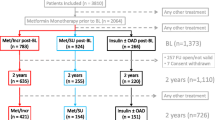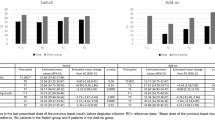Abstract
The aim of the present cohort study is the assessment of treatment failure rates in patients on monotherapy with metformin or insulin secretagogues, observed in a routine clinical setting. A cohort of patients without any pharmacological treatment was also observed. A retrospective observational cohort study was performed on a consecutive series of 2,020 type 2 diabetic patients receiving monotherapy with an oral agent (metformin or insulin secretagogue, n = 1,126) or drug-naive (n = 894). HbA1c and prescribed hypoglycemic therapy were recorded yearly. Patients were followed until death, change of residence, failure to treatment, or up to 48 months. The mean duration of follow up was 34.8 ± 18.0 months. In a Cox regression analysis, metformin was associated with a significant reduction, and insulin secretagogues with a significant increase, in the risk of failure to therapy during follow up. When duration of diabetes and baseline BMI were added to the model, insulin secretagogues, but not metformin, were still associated with increased risk of failure. In conclusion, insulin secretagogues are associated with increased failure rate in comparison with metformin. This difference could be due to detrimental effect of secretagogues, rather than to a beneficial action of metformin.


Similar content being viewed by others
References
UK Prospective Diabetes Study (UKPDS) Group (1998) Intensive blood-glucose control with sulphonylureas or insulin compared with conventional treatment and risk of complications in patients with type 2 diabetes (UKPDS 33). Lancet 352(9131):837–853
Patel A, MacMahon S, Chalmers J et al (2008) Intensive blood glucose control and vascular outcomes in patients with type 2 diabetes. N Engl J Med 358(24):2560–2572
UK Prospective Diabetes Study (UKPDS) Group (1998) Effect of intensive blood-glucose control with metformin on complications in overweight patients with type 2 diabetes (UKPDS 34). Lancet 352(9131):854–865
Abraira C, Duckworth WC, Moritz T (2008) Glycaemic separation and risk factor control in the Veterans affairs diabetes trial: an interim report. Diabetes Obes Metab 11:150–156
Gerstein HC, Miller ME, Byington RP et al (2008) Effects of intensive glucose lowering in type 2 diabetes. N Engl J Med 358(24):2545–2559
Turner RC, Cull CA, Frighi V, Holman RR, UK Prospective Diabetes Study (UKPDS) Group (1999) Glycemic control with diet, sulfonylurea, metformin, or insulin in patients with type 2 diabetes mellitus: progressive requirement for multiple therapies (UKPDS 49). JAMA 281(21):2005–2012
Kahn SE, Haffner SM, Heise MA et al (2006) Glycemic durability of rosiglitazone, metformin, or glyburide monotherapy. N Engl J Med 355(23):2427–2443
Matthews DR, Cull CA, Stratton IM, Holman RR, Turner RC, UK Prospective Diabetes Study (UKPDS) Group (1998) UKPDS 26: sulphonylurea failure in non-insulin-dependent diabetic patients over 6 years. Diabet Med 15(4):297–303
Chalmers J, MacMahon S, Mancia G et al (1999) 1999 World Health Organization-international society of hypertension guidelines for the management of hypertension. Guidelines sub-committee of the World Health Organization. Clin Exp Hypertens 21(5–6):1009–1060
Young M, Breddy J, Veves A, Boulton A (1994) The prediction of diabetic neuropathic foot ulceration using vibration perception thresholds: a prospective study. Diabetes Care 17:557–560
Blackburn H (1969) Classification of the elettrocardiogram for population studies: Minnesota code. J Elettrocardiol 2:305–310
Charlson M, Szatrowski T, Peterson T, Gold J (1994) Validation of a combined comorbidity index. J Clin Epidemiol 47:1245–1251
Eurich DT, Simpson SH, Majumdar SR, Johnson JA (2005) Secondary failure rates associated with metformin and sulfonylurea therapy for type 2 diabetes mellitus. Pharmacotherapy 25(6):810–816
Riedel AA, Heien H, Wogen J, Plauschinat CA (2007) Loss of glycemic control in patients with type 2 diabetes mellitus who were receiving initial metformin, sulfonylurea, or thiazolidinedione monotherapy. Pharmacotherapy 27(8):1102–1110
Del Guerra S, Marselli L, Lupi R et al (2005) Effects of prolonged in vitro exposure to sulphonylureas on the function and survival of human islets. J Diabetes Complicat 19(1):60–64
Lupi R, Del GS, Marselli L et al (2004) Rosiglitazone prevents the impairment of human islet function induced by fatty acids: evidence for a role of PPARgamma2 in the modulation of insulin secretion. Am J Physiol Endocrinol Metab 286(4):E560–E567
Del Prato S, Bianchi C, Marchetti P (2007) β-cell function and anti-diabetic pharmacotherapy. Diabetes Metab Res Rev 23:518–527
Viberti G, Kahn SE, Greene DA et al (2002) A diabetes outcome progression trial (ADOPT): an international multicenter study of the comparative efficacy of rosiglitazone, glyburide, and metformin in recently diagnosed type 2 diabetes. Diabetes Care 25(10):1737–1743
Conflict of interest statement
No potential conflict of interest relevant to this article was reported.
Author information
Authors and Affiliations
Corresponding author
Rights and permissions
About this article
Cite this article
Pala, L., Monami, M., Lamanna, C. et al. Failure to metformin and insulin secretagogue monotherapy: an observational cohort study. Acta Diabetol 47 (Suppl 1), 7–11 (2010). https://doi.org/10.1007/s00592-009-0104-9
Received:
Accepted:
Published:
Issue Date:
DOI: https://doi.org/10.1007/s00592-009-0104-9




